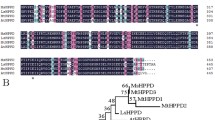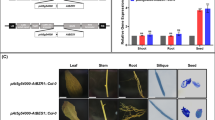Abstract
Arabidopsis Cytochrome P450 85A2 (AtCYP85A2) was introduced to Arabidopsis thaliana seeds using a seed-specific promoter, pAt5g54000. GUS (β-Glucuronidase) activity and RT-PCR analysis demonstrated that AtCYP85A2 overexpression only occurred in seeds of a transgenic plant, pAt5g54000-AtCYP85A2::Col-0. A crude enzyme solution prepared pAt5g54000-AtCYP85A2::Col-0 seeds successfully catalyzed the conversion of castasterone (CS) to brassinolide (BL), which was not detected in wild-type seeds. Furthermore, a higher level of CS and BL was detected in pAt5g54000-AtCYP85A2::Col-0 seeds compared to untransformed seeds, thus demonstrating that seed-specific overexpression of AtCYP85A2 efficiently encoded a bi-functional enzyme for brassinosteroids 6-oxidase/brassinolide synthase to generate CS and BL in seeds of pAt5g54000-AtCYP85A2::Col-0. Compared to the wild type, pAt5g54000-AtCYP85A2::Col-0 produced substantially larger seeds with a high concentration of nutrients due to an enhancement in brassinosteroids signaling. Additionally, pAt5g54000-AtCYP85A2::Col-0 exhibited superior seed germination, seedling and rosette plant growth, and flower and silique formation, indicating that seed-specific AtCYP85A2 expression activates overall vegetative and reproductive growth and development in A. thaliana.






Similar content being viewed by others
References
Bajguz A (2007) Metabolism of brassinosteroids in plants. Plant Physiol Biochem 45(2):95–107
Bajguz A, Tretyn A (2003) The chemical characteristic and distribution of brassinosteroids in plants. Phytochemistry 62(7):1027–1046
Clough SJ, Bent AF (1998) Floral dip: a simplified method for Agrobacterium-mediated transformation of Arabidopsis thaliana. Plant J 16(6):735–743
Focks N, Benning C (1998) wrinkled1: a novel, low-seed-oil mutant of Arabidopsis with a deficiency in the seed-specific regulation of carbohydrate metabolism. Plant Physiol 118(1):91–101
Fujioka S, Noguchi T, Yokota T, Takatsuto S, Yoshida S (1998) Brassinosteroids in Arabidopsis thaliana. Phytochemistry 48(4):595–599
Glazebrook J, Weigel D (2002) Arabidopsis: a laboratory manual. Cold Spring Harbor Laboratory Press, New York
Grove MD, Spencer GF, Rohwedder WK, Mandava N, Worley JF, Warthen JD, Steffens GL, Flippen-Anderson JL, Cook JC (1979) Brassinolide, a plant growth-promoting steroid isolated from Brassica napus pollen. Nature 281(5728):216–217
He J-X, Gendron JM, Yang Y, Li J, Wang Z-Y (2002) The GSK3-like kinase BIN2 phosphorylates and destabilizes BZR1, a positive regulator of the brassinosteroid signaling pathway in Arabidopsis. Proc Natl Acad Sci 99(15):10185–10190
Jiang W-B, Huang H-Y, Hu Y-W, Zhu S-W, Wang Z-Y, Lin W-H (2013) Brassinosteroid regulates seed size and shape in Arabidopsis. Plant Physiol 162(4):1965–1977
Kim T-W, Wang Z-Y (2010) Brassinosteroid signal transduction from receptor kinases to transcription factors. Annu Rev Plant Biol 61:681–704
Kim T-W, Hwang J-Y, Kim Y-S, Joo S-H, Chang SC, Lee JS, Takatsuto S, Kim S-K (2005) Arabidopsis CYP85A2, a cytochrome P450, mediates the Baeyer-Villiger oxidation of castasterone to brassinolide in brassinosteroid biosynthesis. Plant Cell 17(8):2397–2412
Kim T-W, Guan S, Burlingame AL, Wang Z-Y (2011) The CDG1 kinase mediates brassinosteroid signal transduction from BRI1 receptor kinase to BSU1 phosphatase and GSK3-like kinase BIN2. Mol Cell 43(4):561–571
Kim S, Moon J, Roh J, Kim S-K (2018) Castasterone can be biosynthesized from 28-homodolichosterone in Arabidopsis thaliana. J Plant Biol 61(5):330–335
Li N, Xu R, Li Y (2019) Molecular networks of seed size control in plants. Annu Rev Plant Biol 70:435–463
Mishra SK, Suh WI, Farooq W, Moon M, Shrivastav A, Park MS, Yang J-W (2014) Rapid quantification of microalgal lipids in aqueous medium by a simple colorimetric method. Bioresour Technol 155:330–333
Montoya T, Nomura T, Yokota T, Farrar K, Harrison K, Jones JG, Kaneta T, Kamiya Y, Szekeres M, Bishop GJ (2005) Patterns of Dwarf expression and brassinosteroid accumulation in tomato reveal the importance of brassinosteroid synthesis during fruit development. Plant J 42(2):262–269
Nomura T, Kushiro T, Yokota T, Kamiya Y, Bishop GJ, Yamaguchi S (2005) The last reaction producing brassinolide is catalyzed by cytochrome P-450s, CYP85A3 in tomato and CYP85A2 in Arabidopsis. J Biol Chem 280(18):17873–17879
Roh J, Yeom HS, Jang H, Kim S, Youn JH, Kim S-K (2017) Identification and biosynthesis of C-24 ethylidene brassinosteroids in Arabidopsis thaliana. J Plant Biol 60(5):533–538
Roh J, Moon J, Youn J-H, Seo C, Park YJ, Kim S-K (2020) Establishment of biosynthetic pathways to generate castasterone as the biologically active brassinosteroid in Brachypodium distachyon. J Agric Food Chem 68(13):3912–3923
Roh J, Moon J, Lee YE, Park CH, Kim S-K (2021) Seed-specific expression of Arabidopsis AtCYP85A2 produces biologically active brassinosteroids such as castasterone and brassinolide to improve grain yield and quality in seeds of brachypodium distachyon. Front Plant Sci. https://doi.org/10.3389/fpls.2021.639508
Sun Y, Han Z, Tang J, Hu Z, Chai C, Zhou B, Chai J (2013) Structure reveals that BAK1 as a co-receptor recognizes the BRI1-bound brassinolide. Cell Res 23(11):1326–1329
Tang W, Kim T-W, Oses-Prieto JA, Sun Y, Deng Z, Zhu S, Wang R, Burlingame AL, Wang Z-Y (2008) BSKs mediate signal transduction from the receptor kinase BRI1 in Arabidopsis. Science 321(5888):557–560
Tong H, Chu C (2012) Brassinosteroid signaling and application in rice. J Genet Genomics 39(1):3–9
Wang Z-Y, Bai M-Y, Oh E, Zhu J-Y (2012) Brassinosteroid signaling network and regulation of photomorphogenesis. Annu Rev Genet 46:701–724
Yokota T, Arima M, Takahashi N (1982) Castasterone, a new phytosterol with plant-hormone potency, from chestnut insect gall. Tetrahedron Lett 23(12):1275–1278
Acknowledgements
We would like to thank Prof. Jeong Sheop Shin (Korea University, Seoul, Republic of Korea) for providing the seed-specific promoter construct pAt5g54000/pBI101. This work was supported by the National Research Foundation of Korea (NRF) grant funded by the Korean government’s Ministry of Science, ICT, and Future Planning (2021R1A2C1007516).
Author information
Authors and Affiliations
Contributions
S-KK, JR, MHY, and C-HP planned the experiments; MHY, C-HP, and YL carried out the experiments; S-KK, JR, MHY, and C-HP analyzed the data; S-KK, JR, MHY, and C-HP wrote and revised the manuscript for publication. All authors agreed on the contents of this manuscript and declare no conflicts of interest.
Corresponding authors
Supplementary Information
Below is the link to the electronic supplementary material.
Rights and permissions
About this article
Cite this article
Yeon, M.H., Park, CH., Lee, Y.E. et al. Seed-Specifically Overexpressed Arabidopsis Cytochrome P450 85A2 Promotes Vegetative and Reproductive Growth and Development of Arabidopsis thaliana. J. Plant Biol. 65, 75–86 (2022). https://doi.org/10.1007/s12374-021-09340-3
Received:
Revised:
Accepted:
Published:
Issue Date:
DOI: https://doi.org/10.1007/s12374-021-09340-3




